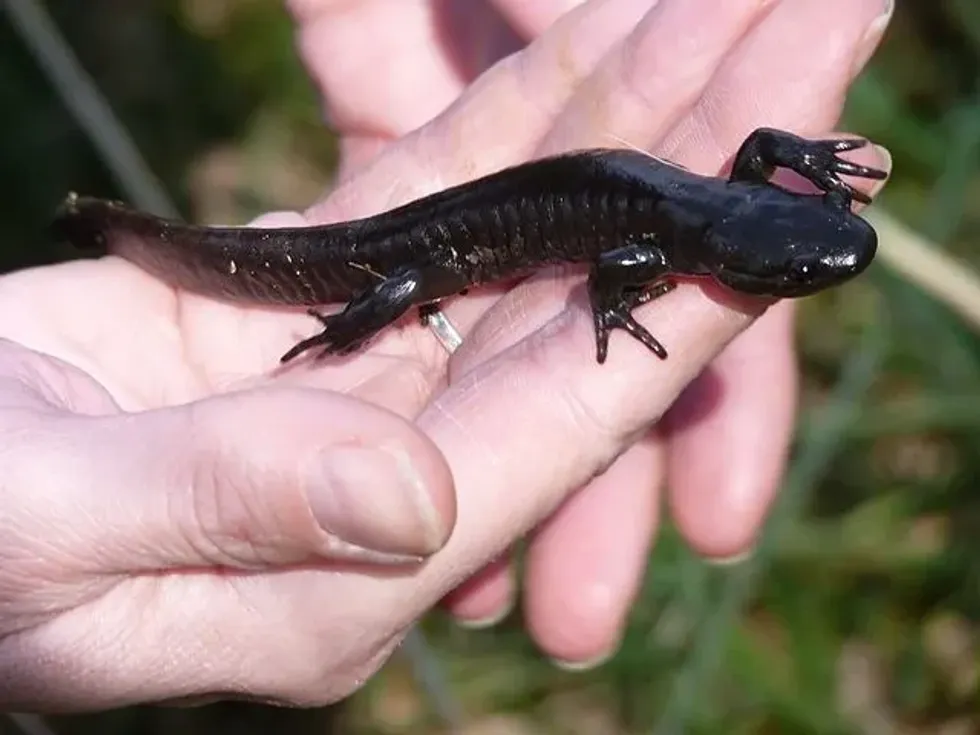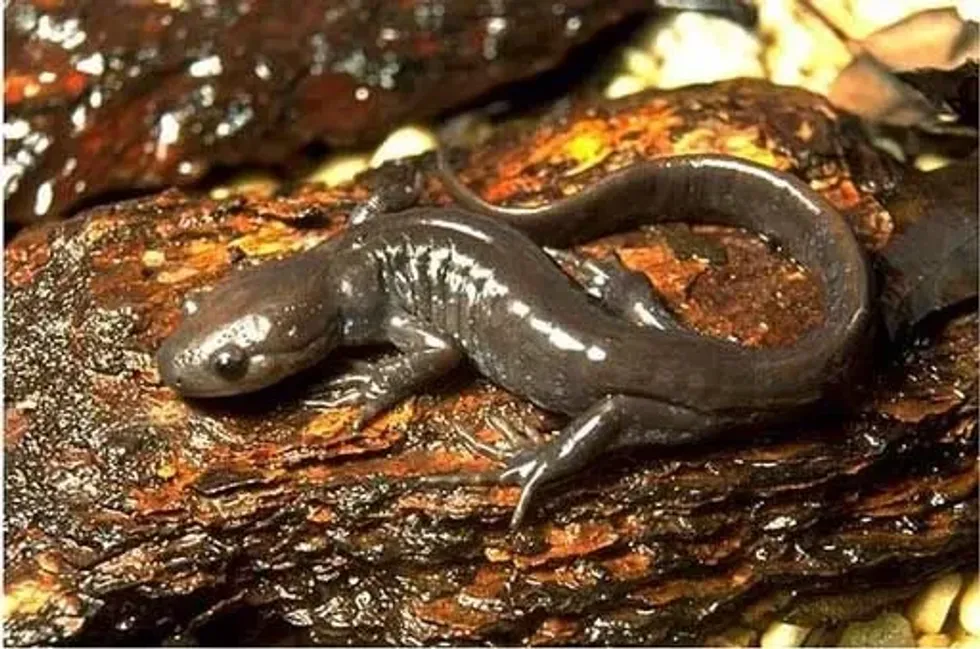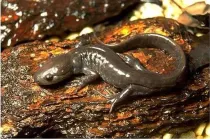Fun Jefferson Salamander Facts For Kids
Are you interested in knowing some cool facts about a special kind of salamander? We present one of the most unique amphibians that exist on this planet, the Jefferson salamander.
The distribution of the habitat of the Jefferson salamander (Ambystoma jeffersonianum) ranges from forests to woodlands. The scientific name of this animal was initially Ambystoma maculatum, which was later changed.
The population of the female is lower in comparison to the males and thus competition among the females is high during breeding season among these salamander species. These salamanders have characteristic speckles or flecks on their body which are blue in color.
These speckles or flecks are found mostly in young ones and decrease with the age of the animal. Like other salamanders, they too lay eggs in masses and their clutch size ranges from 100-280 eggs.
These salamanders have a length of 4.5-7 in (11.4-17.8 cm) and have tiny toes and slender limbs, but a big tail. The tail is almost the size of their body.
When threatened, they can lose their tail from their body and escape predators. However, they have a tail that is regenerative in nature, and with time it grows back.
They hibernate during winter and their ideal sleeping place is wood logs, which provide ideal protection from predators and the cold. Continue reading to know more about the Jefferson salamander range and other cool facts.
For more relatable content, check out these Chinese giant salamander facts and hellbender salamander facts for kids.
Jefferson Salamander Interesting Facts
What type of animal is a Jefferson salamander?
As evident from its name, the Jefferson salamanders (Ambystoma jeffersonianum) are a type of mole salamander.
What class of animal does a Jefferson salamander belong to?
The Jefferson salamander, of the mole salamanders group, belongs to the class of Amphibia of the Animalia kingdom. Other salamanders, like the blue-spotted salamanders, also belong to the class of Amphibia. All mole salamanders, including Jefferson and blue-spotted salamanders, belong to the genus Ambystoma.
How many Jefferson salamanders are there in the world?
Due to extremely limited data, it is difficult to put a number on the mature Jefferson salamander individuals present on our planet. Moreover, the presence of numerous unisex individuals of the species messes up the counting.
However, scientists and biologists as per the International Union for Conservation of Nature or the IUCN Red List make a claim that there are more than 10,000 unhybridized individuals present on earth. Human activities like habitat loss and road mortality have led to a decline in their population.
Where does a Jefferson salamander live?
The Jefferson salamander is a species of mole salamanders, that are endemic to the geographical range of North America. These animals are distributed in the range of the USA like West Virginia, Indiana, Kentucky, and others. Some portion of their population is also found in New England.
What is a Jefferson salamander's habitat?
The primary Jefferson salamander habitat includes forests and wetlands. These mole salamanders prefer the kind of habitat that serves as perfect breeding ponds and breeding pools like any woodland pond.
Other than that, they also prefer similar habitat that includes woodlands, deciduous and upland forests. During winters, these animals hibernate in rodent burrows and wood logs that are located below the frost line.
Who do Jefferson salamanders live with?
Due to a substantial lack of data, not much is known about the social behavior of the Jefferson salamanders. However, we can draw a conclusion by comparing them with their family.
Since salamanders are solitary animals and can be seen in groups only during the mating or breeding season, it is no different in the case of Jefferson salamanders. The favorite breeding site of these animals are ponds, and during the mating season, adults form groups of two or four can be seen together.
How long does a Jefferson salamander live?
The average life span of a Jefferson salamander is estimated to be roughly around six years. Scientists also estimate that these animals can live more than six years in the wild.
How do they reproduce?
The Jefferson salamander, like many other animals, displays courtship rituals. There is always a disproportion in the ratio of females to males and thus, competition is often observed among the female of this species.
During the phase of the courtship ritual, the males of the adult salamanders are known to rub their snouts and undulate their tails.
The Jefferson salamander breeding period occurs when the temperature is relatively cooler like early spring or late winter. The males are known to be annual breeders, while the females are often known to skip a year.
The gestation period is relatively less in comparison to other animals and lasts for one or two days.
The eggs are carefully laid under vegetation on the forest floor to avoid the notice of predators. Egg masses differ from individual to individual, however, the clutch size remains in the range of 100-280 eggs.
In captivity and under ideal and controlled temperature and conditions, the Jefferson salamander eggs hatch within a span of two weeks; however, that is not the case in the wild. Under the natural conditions of the forest, the eggs take a relatively greater time to hatch.
The eggs hatch after almost 14 weeks and Jefferson salamander larvae originate.
Like most amphibians, metamorphosis is a very important process and this larvae completely changes into salamanders within two to three months. These newly metamorphosed salamanders attain their sexual maturity after a span of two to three years.
What is their conservation status?
The Jefferson salamander has been listed as a species of Least Concern by the International Union for Conservation of Nature or the IUCN Red List. The population trend status of these salamanders is also stable.
However, numerous human activities often cause substantial harm to their life and livelihood. Since the primary habitat of these animals are forests, the constant habitat destruction by practices like deforestation has often caused harm to the conservation status of mole salamanders.
Jefferson Salamander Fun Facts
What do Jefferson salamanders look like?
The Jefferson salamander (Ambystoma jeffersonianum) is a very charismatic creature, as is evident from its looks. This animal has characteristic brownish-gray skin with numerous light blue spots that helps in its identification.
These spots can be found on its sides, tail, and on its back. The most important thing about the spots or the speckling is their brightness.
With the passage of time, as the salamanders grow old, the spots start fading. Thus, it is very easy to identify old salamander individuals from the new of these species. Other physical characteristics include small round heads, thin limbs, and tiny toes.
The tail is quite long and is almost of the same size as the body of the salamander. The females are relatively larger in size in comparison to their male counterparts.
As many as 12-14 coastal grooves are present in the females. The freshly grown larvae are yellowish-green in color and have external gill slits, which help in breathing.

How cute are they?
Though some people consider these animals to be cute, a majority of the human population finds these salamanders to be hideous and not at all appealing.
How do they communicate?
Just like the other species of salamanders communicate, the Jefferson salamander, too, communicates in the same ways. Unlike other amphibians, salamanders are not vocal and thus, they rely on their senses for communication. Salamanders usually communicate through touch and by the secretion of chemicals.
How big is a Jefferson salamander?
The size of the Jefferson salamander lies in the range of 4.5-7 in (11.4-17.8 cm) in length. In comparison to the Cope's giant salamander, which has an average length of 4.7-7.5 in (12-19 cm), these two species are almost similar in size and shape. The blue-spotted salamander is near twice the size of arboreal salamanders.
How fast can a Jefferson salamander move?
Owing to very limited information, there is not any substantial data that gives us information about the speed of Jefferson salamanders. However, we can make a guess on their speed by comparing them with other species of salamanders.
In general, Jefferson salamanders are not too prone to show movement of any kind, we can assume that their speed is slow and well below the 15 mph (24.1 kph) mark.
How much does a Jefferson salamander weigh?
Jefferson salamanders are small animals and just like their size, their weight is also pretty small. These animals have weights that lie in the range of 0.3-0.4 lb (120-200 g).
What are the male and female names of the species?
There is no distinct name given to the males and the females of these species. Thus, they are usually referred to as male and female Jefferson salamanders.
What would you call a baby Jefferson salamander?
Though the freshly hatched salamanders are termed as larvae, they, also, have a separate name ascribed to them. Baby salamanders are referred to as salamander nymphs and thus, in the case of Jefferson salamander, the baby is called a Jefferson salamander nymph.
What do they eat?
These species of salamanders are carnivorous in nature and are known to prey on a wide range of insects and other small invertebrates. Adult Jefferson salamanders usually hide from plain eyesight and lie under vegetation and leaf litter, making their feeding habits unknown.
But scientists assume that they feed on worms and other small insects that are found in the ground.
After freshly hatching from the egg, the larvae of these salamanders are known to feed on zooplankton that is found in water.
They also feed on snails. Where there is a shortage of food, the cannibalistic behavior of the larvae kicks in for their survival and these larvae start killing and feeding on other larvae of the same species.
Are they poisonous?
Salamanders have a certain amount of poison on their skin, which differs from one species to another. Though there is not much information about the toxicity of the Jefferson salamander, we can assume that the toxin content is relatively low, owing to it being an inoffensive animal by nature.
Would they make a good pet?
Yes, like the majority of other salamanders, the Jefferson salamander makes an excellent pet. They are not very active as pets. Jefferson salamander care is pretty easy; and if proper care and environment are provided to them, they become very good pets.
Did you know...
The Jefferson salamanders are extremely stubborn creatures and they rarely move from one place to another. Such is their laziness to move, that almost 50% of these animals die during their annual period of hibernation, as they remain in cold places and don't move to warm places.
Their nature of traveling is also very less and scientists have found out that these animals rarely travel even one mile (1.6 km) during their lifespan.
Many hybrids of the species exist, and they were once thought to be different species. But the hybrids have now been included in a group along with the Jefferson salamander. The group is known as the 'Jefferson Complex'.
Why is it called Jefferson salamander?
This salamander is named after the prestigious Jefferson college located in Pennsylvania. The college, however, has been named after former US President Thomas Jefferson. Thus, we can say that this species of salamander is indirectly named after a former US President.
How to keep a Jefferson salamander as a pet
The most important thing which you need to make sure of while keeping a Jefferson salamander as a pet is to recreate its primary habitat. These animals love staying in woodlands and forests and thus, the exact habitat with proper climatic conditions should be maintained in the enclosure.
Since these animals prefer moist climatic conditions, at least 70% humidity should be maintained to ensure that the skin of these animals stays moist.
These animals also prefer aquatic places and hence, the substrate should be ideally similar and filled with leaves, twigs, sand, cover objects, and other decorative plants. Since these animals feed on insects, the best food to offer them is live insects.
Here at Kidadl, we have carefully created lots of interesting family-friendly animal facts for everyone to discover! Learn more about some other amphibians from our spring salamander facts and fire salamander facts pages.
You can even occupy yourself at home by coloring in one of our free printable jefferson salamander coloring pages.
We Want Your Photos!
More for You
Bachelor of Arts specializing in Journalism and Mass Communication, Postgraduate Diploma in Sports Management

Moumita DuttaBachelor of Arts specializing in Journalism and Mass Communication, Postgraduate Diploma in Sports Management
A content writer and editor with a passion for sports, Moumita has honed her skills in producing compelling match reports and stories about sporting heroes. She holds a degree in Journalism and Mass Communication from the Indian Institute of Social Welfare and Business Management, Calcutta University, alongside a postgraduate diploma in Sports Management.
Disclaimer
1) Kidadl is independent and to make our service free to you the reader we are supported by advertising. We hope you love our recommendations for products and services! What we suggest is selected independently by the Kidadl team. If you purchase using the Buy Now button we may earn a small commission. This does not influence our choices. Prices are correct and items are available at the time the article was published but we cannot guarantee that on the time of reading. Please note that Kidadl is a participant in the Amazon Services LLC Associates Program, an affiliate advertising program designed to provide a means for sites to earn advertising fees by advertising and linking to Amazon. We also link to other websites, but are not responsible for their content.
2) At Kidadl, we strive to recommend the very best activities and events. We will always aim to give you accurate information at the date of publication - however, information does change, so it’s important you do your own research, double-check and make the decision that is right for your family. We recognise that not all activities and ideas are appropriate for all children and families or in all circumstances. Our recommended activities are based on age but these are a guide. We recommend that these ideas are used as inspiration, that ideas are undertaken with appropriate adult supervision, and that each adult uses their own discretion and knowledge of their children to consider the safety and suitability. Kidadl cannot accept liability for the execution of these ideas, and parental supervision is advised at all times, as safety is paramount. Anyone using the information provided by Kidadl does so at their own risk and we can not accept liability if things go wrong.
3) Because we are an educational resource, we have quotes and facts about a range of historical and modern figures. We do not endorse the actions of or rhetoric of all the people included in these collections, but we think they are important for growing minds to learn about under the guidance of parents or guardians.







